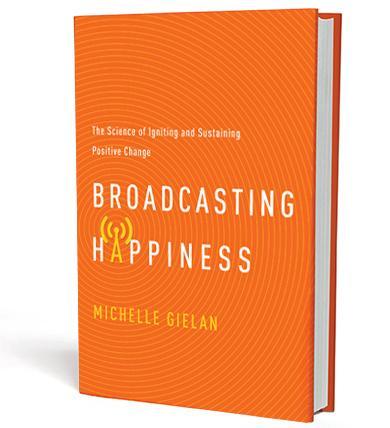
We've all been told countless times "You can't change other people." But this societal belief is not only disempowering, it is, perhaps surprisingly, scientifically FALSE.
Today, I am pleased to introduce you to researcher and bestselling author of , .
Michelle, along with her husband and famed TED presenter, Shawn Achor are partnering with PBS for an INSPIRE HAPPINESS television special that started airing in December 2016, focusing on the powerful message:
When we are able to make others happier and more successful, we feel happier too.
Drawing on research from positive psychology and neuroscience, Michelle Gielan provides a compelling scientific case that shows we change people ALL the time, and when we apply the research to our everyday lives, we can move the people we care about to a more positive, resilient state.
I am inclined to agree with this wholeheartedly, and I am thrilled to have Michelle here today with a guest post on my favorite topic-happiness-what this blog is all about. Also, I can vouch for the three tips she shares from her book-they work!
Welcome, Michelle! And while I go make some coffee for all of us, Michelle will talk to you.
And while I go make some coffee for all of us, Michelle will talk to you. By Michelle Gielan
By Michelle Gielan The Science of How to Navigate Negativity and Create Happiness
One day I showed up to computer giant Hewlett-Packard to deliver a keynote on the business value of broadcasting happiness in the midst of challenges. Before I had even stepped onstage, an announcement had been made that layoffs were imminent. HP was expecting to cut more than fifty-five thousand positions. (And now here is a talk on happiness from a happiness researcher - oy!)
Our brains are incredible processors. And brain fuel is empowering information.Addressing that crowd, I explained that they needed this research more than ever to help them wade through the barrage of bad news that would keep streaming in. After my talk at HP, to my surprise, a senior technology manager told me how he was actually looking forward to the restructuring because it might mean he'd get a different boss and be better inoculated against the stress and negativity he'd been experiencing. He was actively searching for the positive in a sea of negativity.
We can process 40-50 bits of information each second, but the challenge is that our brain is bombarded by more than 11 million bits of information each second. Inherently there are choices in how we devote our attention. Focus on the positive with an empowered spirit in the face of challenges, and our research shows you fuel your happiness and success.
It thrills me that, after more than a decade of research, we have been able to isolate certain positive habits that create a more positive mindset and buffer our brains against the effects of stress. For those of us who are busy with an active life full of work, family, and a million responsibilities, the best news is that these routines take just a minute or two each day. (And you won't need a butt exercise machine to do them.)
1) SEND A POSITIVE EMAILAdapted from my book Broadcasting Happiness, here are the top three ways to build a positive mindset. We encourage you to pick one of these habits and do it every day for a period of twenty-one days. Research shows that doing something for twenty-one consecutive days helps us to build a life habit. These habits will help inoculate your brain against stress and negativity from the outside world by shifting the lens through which you view your life to a more positive one.
How to do it: Every day for twenty-one days, first thing in the morning, send a short positive email of praise or thanks to someone you know. The goal is to draft the email in two minutes or less. Recipients can include colleagues, your spouse, a childhood friend, or even someone you don't know too well, such as the security guard at the front desk of your office. If you don't have their email address, consider a quick handwritten note. The key is to tell these people at least one way in which they have made a positive difference in your life.
2) COLLECT YOUR GRATITUDESWhy it works: Sometimes it feels as though thinking about a negative person consumes our mental resources. Our brain churns as we consider the ill effects this person is having on us and how we are going to handle future encounters. We also often forget about all the life-giving people we have in our lives. This exercise, in just minutes each day, reminds our brain of our deep social-support network and puts into perspective the size of the role that the negative person actually plays in our life. Social support is one of the greatest predictors of happiness. And every time we meaningfully connect with one of our email recipients, we shrink the level of influence the negative person has on our life. That space becomes filled with positive, soul-nourishing people who only make our lives better.
How to do it: Every day, for twenty-one days, write down three new and unique things you are grateful for in life. Make sure to be specific and to briefly explain why you are grateful for them. For instance, you might write that you are grateful today because your son told you he loves you, which made you feel very special. It is important to come up with new items each day so that at the end of the three weeks, you have more than sixty-three documented gratitudes.
3) SNAP A POSITIVE PICTUREWhy it works: Actively cataloguing the things you are grateful for in life trains your brain to scan the world in a more positive way. Instead of scanning for things to complain or be stressed about, your brain starts to first focus on the parts of your life that are positive and meaningful. In just one to two minutes a day, you can build new neural pathways in your brain for higher levels of positivity. In a study conducted at Eastern Washington University, researchers found that listing three gratitudes for just one week not only produced a significant boost in feelings of well-being while engaging in the practice, but also it continued to climb for participants weeks after the practice ended. In a similar study-this one conducted with a group of people aged sixty and older-researchers found that a two-week gratitude practice led to a significant rise in well-being that held steady even a month after participants had stopped counting their gratitudes. Engaging in the quick daily habit had lasting effects on their happiness.
How to do it: Every day for twenty-one days, take at least one picture of a meaningful moment or thing in your life-a sunset, your child sleeping, a project at work you successfully finished, or perhaps the meal your spouse cooked that night. Make sure to capture a moment in which you felt positive emotions, such as happiness, gratitude, joy, peace, serenity, or love. At the end of each week, scroll through the pictures you took to remind yourself of the emotional highlights of the week.
Why it works: Photos can trigger emotions in just seconds, even decades after they were taken. The positive pictures you take remind you of the emotions you felt while taking them, and by reviewing them, you effectively relive those times, doubling the amount of positive emotions you felt as a result. Additionally, the practice of taking photos of positive subjects on a regular basis trains your brain to watch for moments to capture. Similar to the effect that counting your gratitudes can have on your mindset, positive pictures can cause you to feel more optimistic as you literally begin to adjust your viewpoint of the world.
It may seem like these easy little habits are too simple to spark big changes in your mindset and energy levels, but we've read about the positive effects in the thousands of stories we've received from people. Doing one of these positive habits (or more if you feel so inclined) refocuses your attention on the positive and meaningful parts of your day, which, by default, ends up shrinking the power negative people have over your mindset; they lose their ability to strongly influence how you experience the world.
The simple act of practicing gratitude or scanning the world for the positive shifts the focus away from stress and negativity, not to mention it gives us the unique energy boost that comes from remembering the best moments from our life and the positive emotions we experienced during them. It won't help us avoid serious issues like the layoffs at HP, but it will help us navigate them better.
About MichelleFor more research and ideas to start your day off on a positive note, I invite you to join me for our (free) Wake Up & Inspire Happiness Video Workshop, based on our new PBS program INSPIRE HAPPINESS airing nationwide. And on social media @michellegielan
Michelle Gielan, national CBS News anchor turned positive psychology researcher, is the bestselling author of Broadcasting Happiness. She is the Founder of the Institute for Applied Positive Research and is partnered with Arianna Huffington to study how transformative stories fuel success. Michelle is an Executive Producer of "The Happiness Advantage" Special on PBS and a featured professor in Oprah's Happiness course.

Interested in "Broadcasting Happiness"? Take a look:

Writer, editor, blogger, social media enthusiast. Love DIY, Coffee, Music, Reading, Photography, Family, Friends and Life. Mantra: Happiness is a DIY Project. In my free time I play with my dust bunnies and show my diabetes who's boss. Tweet as @vidyasury

